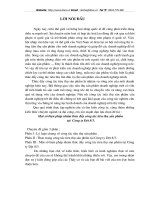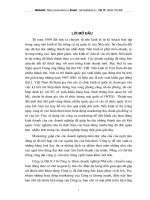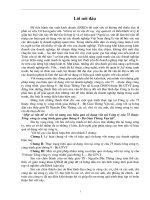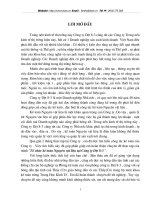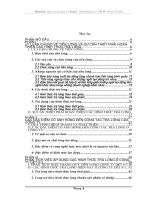8 ch15 rocksmineralmixtures
Bạn đang xem bản rút gọn của tài liệu. Xem và tải ngay bản đầy đủ của tài liệu tại đây (1.43 MB, 58 trang )
8th Grade Science
© Fall 2005, Pflugerville ISD, 8th Grade
Chapter 15- Rocks: Mineral
Mixtures
Section 1: From Minerals to Rocks
Section 2: Igneous Rocks
Section 3: Sedimentary Rock
Section 4: Metamorphic Rock
© Fall 2005, Pflugerville ISD, 8th Grade
Unit 3 : Chapter 15
What is a Mineral?
What Do You Think?
What are some items you use in your
everyday life that come from minerals?
© Fall 2005, Pflugerville ISD, 8th Grade
Unit 3 : Chapter 15 : Secti
What is a Mineral?
Halite Crystal (NaCl)
© Fall 2005, Pflugerville ISD, 8th Grade
•All minerals
must meet the
following five
characteristics:
Unit 3 : Chapter 15 : Secti
What is a Mineral?
•Natural,
inorganic solid
that forms a
crystal lattice
and
has
a
Halite Crystal (NaCl)
chemical
formula
© Fall 2005, Pflugerville ISD, 8th Grade
Unit 3 : Chapter 15 : Secti
What is a Mineral?
Halite Crystal (NaCl)
© Fall 2005, Pflugerville ISD, 8th Grade
•Since they form
crystals, all
minerals are
ionic compounds
Unit 3 : Chapter 15 : Secti
Types of Minerals
•Minerals are
grouped by the
chemicals in them
Muscovite
crystal under
microscope
© Fall 2005, Pflugerville ISD, 8th Grade
•Silicate minerals
contain silicon
and oxygen
Unit 3 : Chapter 15 : Secti
Silicate Minerals
Muscovite
crystal under
microscope
© Fall 2005, Pflugerville ISD, 8th Grade
•Over 90% of
the minerals in
Earth’s crust
are silicates
Unit 3 : Chapter 15 : Secti
Nonsilicate Minerals
•Nonsilicates
are minerals
that do not
contain silicon
Calcite (CaCO3)
© Fall 2005, Pflugerville ISD, 8th Grade
Unit 3 : Chapter 15 : Secti
Nonsilicate Minerals
Calcite (CaCO3)
© Fall 2005, Pflugerville ISD, 8th Grade
•Nonsilicates
are made of
elements such
as carbon,
oxygen, iron
and sulfur
Unit 3 : Chapter 15 : Secti
Nonsilicate Minerals
Calcite (CaCO3)
© Fall 2005, Pflugerville ISD, 8th Grade
•Carbonates,
such as calcite,
are used in
cement, building
stone, and
fireworks
Unit 3 : Chapter 15 : Secti
Nonsilicate Minerals
Halite (NaCl)
© Fall 2005, Pflugerville ISD, 8th Grade
•Halide
minerals
are used in
fertilizer, or
to season
your food
Unit 3 : Chapter 15 : Secti
Nonsilicate Minerals
Corundum (Al2O3)
© Fall 2005, Pflugerville ISD, 8th Grade
•Oxide
minerals are
used to make
abrasives and
aircraft parts
Unit 3 : Chapter 15 : Secti
Nonsilicate Minerals
Gypsum (CaSO4•2H2O)
© Fall 2005, Pflugerville ISD, 8th Grade
•Sulfates are
used in
cosmetics,
toothpaste,
and paint
Unit 3 : Chapter 15 : Secti
Identifying Minerals
•Geologists use physical properties
such as color, luster, streak, and
many others to identify minerals
© Fall 2005, Pflugerville ISD, 8th Grade
Unit 3 : Chapter 15 : Secti
Identifying Minerals
•Quartz and
amethyst are both
SiO2, but amethyst
contains impurities
that
give
it
a
purple
Quartz/Amethyst
color
Scepter (SiO )
2
© Fall 2005, Pflugerville ISD, 8th Grade
Unit 3 : Chapter 15 : Secti
Identifying Minerals
•Because a single
mineral can be
many colors, color
is not a reliable
way to identify a
Quartz/Amethyst
mineral
Scepter (SiO )
2
© Fall 2005, Pflugerville ISD, 8th Grade
Unit 3 : Chapter 15 : Secti
Identifying Minerals
Galena (PbS)Metallic Luster
© Fall 2005, Pflugerville ISD, 8th Grade
•The way the
surface of a
mineral
reflects light is
called luster
Unit 3 : Chapter 15 : Secti
Identifying Minerals
•Bauxite, the ore
of aluminum, has
a nonmetallic
luster
Bauxite (Al2O3•2H2O)Earthy Luster
© Fall 2005, Pflugerville ISD, 8th Grade
Unit 3 : Chapter 15 : Secti
Identifying Minerals
•Streak is the
color of a
mineral in
powdered form
© Fall 2005, Pflugerville ISD, 8th Grade
Unit 3 : Chapter 15 : Secti
Identifying Minerals
•Hematite’s
color may
change, but
its streak is
always the
same
© Fall 2005, Pflugerville ISD, 8th Grade
Unit 3 : Chapter 15 : Secti
Identifying Minerals
Cleavage Planes
© Fall 2005, Pflugerville ISD, 8th Grade
•Fluorite,
halite, and
calcite all have
cleavage along
flat planes
Unit 3 : Chapter 15 : Secti
Identifying Minerals
Conchoidal Fracture
© Fall 2005, Pflugerville ISD, 8th Grade
•Sulfur has
conchoidal
fracture,
meaning it
breaks
unevenly
Unit 3 : Chapter 15 : Secti
Identifying Minerals
•A mineral’s
resistance to
scratching it is
called hardness
© Fall 2005, Pflugerville ISD, 8th Grade
Unit 3 : Chapter 15 : Secti
Identifying Minerals
•Hardness is
measured using
Mohs’ hardness
scale
© Fall 2005, Pflugerville ISD, 8th Grade
Unit 3 : Chapter 15 : Secti



